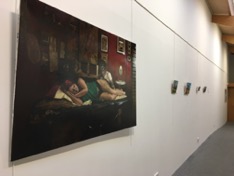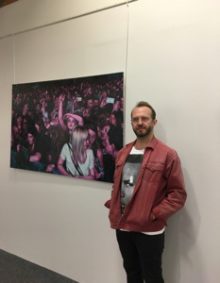Holly Leech’s interview looks into the mind of the inspirational Neil Roberts and his exhibition at the Sam Scorer gallery, available until the 4th of November.

Photo: Holly Leech
Upon entering the Sam Scorer gallery on a bitter Saturday morning, I was immediately hit with a renewed appreciation for witnessing art in it’s finest form. It reminded me of a trip to the Louvre last summer, in which the masterpieces that I had seen on the internet or on smooth, scaled down prints were brought to life. The individual brush strokes, the
little details that aren’t visible until you look closely, even the frame, these are all elements of art you cannot hope to appreciate from a computer screen. Neil Roberts art was meant to be seen in person, but since I sadly couldn’t take all of you with me to the gallery, I will do the next best thing and bring Neil to you!
Which piece currently displayed here today are you most proud of? And why?
The rave pieces are my personal favourites. They represent the modern world, specifically how young people behave and how they enjoy themselves.
Painting individual faces seems quite a personal process, is there any special attraction towards it?
To me, it’s just a question of painting how people look. The idea is that when the paintings are hanging in someone’s home or a gallery in a hundred years time, they will be able to say ‘that’s what people looked like back then’. You might see a Rembrandt painting and, even though they’re wearing strange clothes, you can still recognise there is a human being there. Hopefully, my paintings will achieve something similar. Ultimately, I would like people do remember the modern world in a very representational and honest way.
You’ve essentially immortalised the people in these paintings, which I think is just fantastic. I was actually looking for myself earlier!
Well, hopefully people can see elements of themselves in these paintings. It reflects, quite literally, how people live and how they are nowadays.
I’ve read that you were originally a video games artist, why did you decide to transition back to traditional media?
Making video games relies very much on traditional skills. To make a character, you need to know anatomy or to make a car in a game, you need to understand industrial design. You also need to know things like colour theory. The gaming industry relies very much on your knowledge of the basics of art. To me, it seemed an easy step to make that leap from video game design to something more traditional. It’s essentially the same skills, just a different medium.

Photo: Holly Leech
Your painting style very much reflects older, 18thcentury painting techniques, could you comment on how that process unfolds?
The way I paint is very traditional, it always starts with a drawing. I approach it in the same way the old masters would have done. First, I will lay down a very simple greyscale or single colour, which is called imprimatura. Imprimatura means the first steps of a painting, the initial stain of colour painted on a ground. Then you will glaze over that with another colour until you’re building up layers of oil and medium. It’s almost like chemistry, you need to understand how different paints and pigments work. It’s an old technology but what interests me is using that to create something new.
When did you realise you wanted to pursue a career in art?
I’ve started off, when I was very young, painting pictures of comic book characters and things from books. At school, I was always good at art but the problem was, art isn’t the kind of career path that is easy to obtain advice for because it’s very individual. The reason I got a job in video games was because it allowed me to draw and simultaneously make a living out of it but it got to the point where I’d drawn so many cars and spaceships that I just wanted to start painting real things. I started oil paintings about fifteen years ago, just painting things around the house and I’ve been experimenting with that ever since.
Are there any specific artists that inspire you?
I have a slightly longer view than just 20th century modern art, I go back to Rembrandt, Rubens, Artemisia Gentileschi, or Canaletto for more architectural paintings. If my paintings can hold up to the test of time as much as theirs can, then hopefully I’ll be doing something right.

Photo: Holly Leech
During the interview and after it’s conclusion, I found Neil to be a very intelligent and committed man. I was inspired by his devotion to the craft which is so obvious when you
I’d like to warmly thank Neil for making my debut interview so enlightening, I will certainly be looking out for more of your work in the future!
Neil Robert’s artwork is available to view, share and buy on his website. If you are interested in seeing Neil’s artwork in person, head on over to the Sam Scorer gallery where his art is being exhibited until the 4th November.
